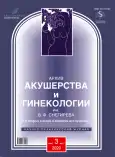Difficulties in the diagnosis of feto-maternal bleeding in the antenatal period
- 作者: Ishchenko A.I.1, Murashko A.V.1, Seredina T.A.1, Minakova A.D.1
-
隶属关系:
- I.M. Sechenov First Moscow State Medical University (Sechenov University)
- 期: 卷 7, 编号 3 (2020)
- 页面: 165-168
- 栏目: Clinical observations
- URL: https://bakhtiniada.ru/2313-8726/article/view/44845
- DOI: https://doi.org/10.17816/2313-8726-2020-7-3-165-168
- ID: 44845
如何引用文章
全文:
详细
Feto-maternal hemorrhage (FMH) is a rare, potentially dangerous event characterized by the passage of fetal blood into the maternal circulation, complicating pregnancy or childbirth. Diagnosis of this condition is based on objective signs: cardiotocography, fetal ultrasound, fetal Doppler, Kleihauer–Betke test (KB) and subjective: assessment of fetal movement activity. If a pregnant woman complains of decreased fetal movement, an experienced doctor should not forget to exclude this dangerous condition. Massive FMH is associated with high perinatal morbidity and fetal mortality.
作者简介
Anatoliy Ishchenko
I.M. Sechenov First Moscow State Medical University (Sechenov University)
Email: 7205502@mail.ru
ORCID iD: 0000-0003-3338-1113
MD, PhD, Professor
俄罗斯联邦, MoscowAndrey Murashko
I.M. Sechenov First Moscow State Medical University (Sechenov University)
编辑信件的主要联系方式.
Email: murashkoa@mail.ru
ORCID iD: 0000-0003-0663-2909
SPIN 代码: 2841-9638
MD, PhD, DSci., Professor, Head of the Department of pathology of pregnancy of the V.F. Snegirev Clinic of Obstetrics and Gynecology of the I.M. Sechenov First Moscow State Medical University, Moscow, prof. Department of Obstetrics and Gynecology No. 1 Institute of Clinical Medicine N.V. Sklifosovsky of the I.M. Sechenov First Moscow State Medical University
俄罗斯联邦, MoscowTat’yana Seredina
I.M. Sechenov First Moscow State Medical University (Sechenov University)
Email: vtrk@yandex.ru
MD, PhD
俄罗斯联邦, MoscowAlena Minakova
I.M. Sechenov First Moscow State Medical University (Sechenov University)
Email: a.minackova2016@yandex.ru
俄罗斯联邦, Moscow
参考
- Stefanovic V. Fetomaternal hemorrhage complicated pregnancy: risks, identification, and management. Curr. Opin. Obstet. Gynecol. 2016;28:86-94.
- Devi B., Jennison R.F., Langley F.A. Significance of placental pathology in transplacental hemorrhage. J. Clin. Pathol.1966;21:322-31.
- Maier J.Th., Schalinski E., Schneider W., Gottschalk U., Hellmeyer L. Fetomaternal hemorrhage (FMH), an update: review of literature and an illustrative case. Arch. Gynecol. Obstetrics. 2015;292:595-602. doi: 10.1007/s00404-015-3686-1
- Bowman J.M., Pollock J.M., Penston L.E. Fetomaternal transplacental hemorrhage during pregnancy and after delivery. Vox Sang. 1986; 51:117-21.
- Sebring E.S., Polesky H.F. Fetomaternal hemorrhage: incidence, risk factors, time of occurrence, and clinical effects. Transfusion. 1990; 30:344-57.
- Giacoia G.P. Severe fetomaternal hemorrhage: a review. Obstet. Gynecol. Survey. 1997;52(6):372-80.
- Bakas P., Liapis A., Giner M., Paterakis G., Creatsas G. Massive fetomaternal hemorrhage and oxytocin contra ction test: Case report and review. Arch. Gynecol. Obstet. 2004;269(2):149-51. doi: 10.1007/s00404-002-0431-3
- Sueters M., Arabin B., Oepkes D. Doppler sonography for predicting fetal anemia caused by massive fetomaternal hemorrhage. Ultras. Obstet. Gynecol. 2003;22(2):186-9. doi: 10.1002/uog.190
- Gibb D., Arulkumaran S., eds. Basics of cardiotocography. Theoretical and clinical aspects.[Osnovy kardiotokografii. Teoreticheskiye i klinicheskiye aspekty]. Transl. from Engl. I.N. Popova; ed. by L.S. Aleksandrov, A.V. Murashko. Logosfera; 2019. (In Russ.)
- Kim Y.A., Makar R.S. Detection of fetomaternal hemorrhage. Am. J. Hematol. 2012;87(4):417-23.
- Sueters M., Arabin B., Oepkes D. Doppler sonography for predicting fetal anemia caused by massive fetomaternal hemorrhage. Ultras. Obstet. Gynecol. 2003;22:186-9.
补充文件







